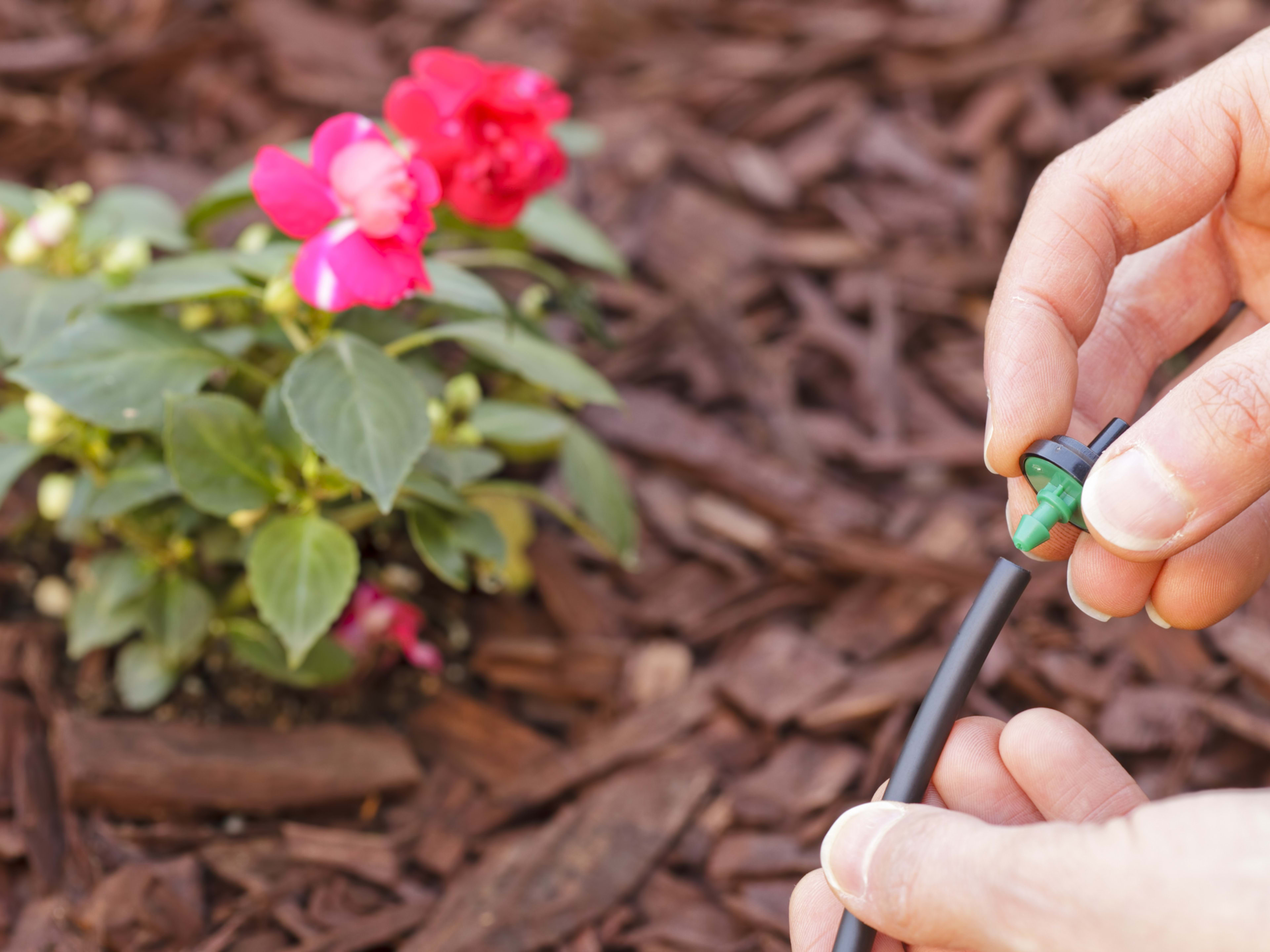Here’s Why You Should Use Drip Irrigation In Your Garden This Season

A man adding an emitter to the end of a drip system 1/4″ hose, with brown mulch and an impatiens plant in the background. Note: Shallow focus on emitter.
\PictureLakeIf your life is busy but you want to make sure your plants are well-cared for, even on your most hectic days, automating your watering system can be a big help. A drip irrigation system is the simplest solution for keeping your garden healthy and growing. There are other benefits to a drip irrigation system that make it a worthwhile investment for professional farmers and DIY gardeners alike.
Experts agree that drip irrigation systems are a great option and aren’t too difficult to set up. “Installing a drip system involves setting up a water source connection, a pressure regulator, a filter, tubing, and emitters or drip lines. It’s relatively simple for a DIY gardener to get started with a kit. Maintenance usually includes flushing the lines once a season, checking for blockages, and replacing worn parts as needed,” says Chris Turner, Founder and CEO of Studio Nisho.
Types of Drip Irrigation Systems
There are four types of drip irrigation systems. Choose the one that works best for your needs and in your garden, depending on layout, plants, terrain, and other features. While some systems may require a substantial financial investment, anywhere from $350 to $4,000, they are a money-saver in the long run, since they conserve water and keep plants growing, eliminating the need for replacements.
Before you decide which system to install, consider the landscape you are managing, especially any slopes or hills, figure out how frequently you’ll need to water, whether it’s a patch of grass or a cutting garden, and plan for the time and budget you’ll need to create a functional drip irrigation system.
Soaker Hoses
Also known as porous soaker lines, soaker hoses have holes throughout that allow slow water seepage into the soil. Soaker hoses can only be used on flat land, and they should be avoided where consumable plants are growing, since the rubber from the hoses can leach into the ground.
Drip Tape
This economical drip irrigation system is laid out in a grid and can be covered with mulch so it disappears into the soil. Keep in mind that drip tape will need to be replaced regularly, since it doesn’t last long. It’s a good option for flower beds and vegetable gardens.
Emitter Systems
Climate change and the unpredictability of the weather has made emitter systems popular, since the water pressure can be adjusted depending on plants’ needs, making them reliable during periods of drought. They can be more work to set up, but will last longer than other systems and are worth the extra effort.
Micro-Misting
Micro-misting is the best choice for larger trees or bigger plots of land. Root zones are gently watered, so shallow-root plants get the most benefit. Micro-misting is the best choice for hilly plots of land. Micro-misters are also helpful for times when buds on plants like hydrangeas and azaleas need to be protected in case of a late frost.
Benefits of Drip Irrigation Systems
Beyond watering your plants when you don’t have time to get to it, drip irrigation systems are beneficial to gardeners for other reasons.
Highly Efficient
Rafi Friedman, President of Coastal Luxury Outdoors, says “They’re highly efficient. Traditional sprinklers cause a huge amount of water loss due to evaporation or missing the plants you’re trying to water. Drip irrigation puts the water right where it’s needed before it can evaporate.” Drip irrigation systems can save up to 80% of the water traditionally used to keep plants alive. Drip irrigation also minimizes the loss of water due to wind drift, since watering is done at ground level.
Conserves Energy
Because drip irrigation requires far lower water pressure than traditional sprinkler systems, it uses much less energy than standard sprinklers do. Drip irrigation systems can be run on an automatic timer to go on and off as needed without much attention.
It’s Better for Your Plants
Drip irrigation puts water directly on the roots of your plants where it can be more efficiently absorbed and used by the plants, especially on hot days. Drip irrigation also discourages weed growth, since targeted watering keeps weeds from getting runoff water that allows them to flourish. Drip irrigation systems are especially helpful in drier climates, where targeted watering can ensure thirsty plants get the soaking they need regularly.
They’re Less Noticeable
Drip irrigation systems are unobtrusive, unlike standard sprinklers that are easily noticed in a garden or lawn. These systems can be installed under mulch or soil, eliminating unwanted water spray on buildings, walkways, outdoor furniture, fences, and walls.
More Time for Enjoying Your Yard
In addition to having less work to do to care for your plants, trees, and lawn, drip irrigation keeps the water from soaking places in your yard that don’t need moisture. You won’t need to wait for the patio or the grass to dry, so you can enjoy a warm afternoon outdoors after you’ve watered your plants. Targeted watering keeps areas damp where they need to be with no overspray.


